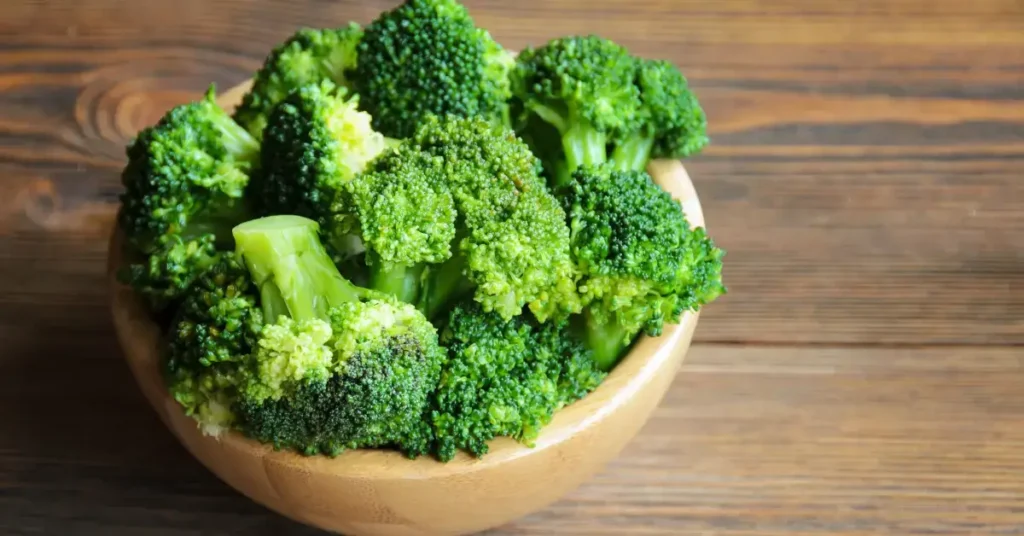
As a dog parent, you’ve probably caught your furry friend giving you those pleading eyes while you’re chopping vegetables for dinner. If broccoli is on your cutting board, you might wonder: “Is it safe to share this green goodness with my pup?”
The short answer is yes—but there’s more to the story than a simple “yes” or “no.”
Broccoli is perfectly safe for dogs when served correctly and in moderation. This nutrient-packed vegetable isn’t toxic to our four-legged friends, but like many good things in life, it comes with some essential guidelines.
The key rule? Keep broccoli treats under 10% of your dog’s daily food intake. This isn’t just a suggestion—it’s crucial for your pet’s health and safety.
Broccoli contains natural compounds called isothiocyanates. While these aren’t harmful in small amounts, they can cause anything from mild stomach upset to severe digestive issues if your dog overeats. When broccoli makes up more than 25% of your dog’s daily food intake, it can actually become toxic.
Think of broccoli as the occasional healthy snack, not a meal replacement.
When given appropriately, broccoli offers some impressive health benefits for dogs:
Vitamin C Powerhouse: Supports your dog’s immune system, helping them fight off illnesses and stay energetic.
Fibre-Rich: Aids digestion and can help your dog feel satisfied between meals—great for weight management.
Antioxidant Protection: These powerful compounds may help reduce inflammation, which is particularly beneficial for senior dogs with joint issues.
Low-Calorie Treat: Perfect for dogs watching their waistline without sacrificing nutrition.
However, remember that high-quality dog food already provides balanced nutrition. Broccoli should complement, not replace, your dog’s regular diet.
Both raw and cooked broccoli are safe options, but each has its considerations:
Raw Broccoli | Cooked Broccoli |
Harder to digest | Easier on the stomach |
Higher risk of choking | Softer, safer texture |
Must be washed thoroughly | Can be steamed or boiled |
Chop into small pieces | Serve completely plain |
More nutrients preserved | Some nutrient loss in cooking |
Pro tip: If you choose cooked broccoli, steam it lightly and never add oils, butter, salt, or seasonings. These additions can be harmful to dogs.
Size Matters: Always cut broccoli into small, bite-sized pieces. The stems, in particular, can pose a choking hazard.
Start Small: Introduce broccoli with just a tiny piece to test your dog’s tolerance. Some dogs have more sensitive stomachs than others.
Plain and Simple: Serve broccoli completely plain—no dressings, seasonings, or cooking oils.
Watch and Wait: Monitor your dog for any signs of digestive upset after their first broccoli experience.
Even with careful preparation, some dogs may experience issues. Watch for these warning signs:
If you notice any of these symptoms, stop giving broccoli immediately and contact your veterinarian.
Puppies deserve extra caution when it comes to new foods. Their developing digestive systems are more sensitive than adult dogs, making them more prone to upset stomachs.
If you want to introduce broccoli to a puppy, start with an even smaller amount and watch closely for any adverse reactions.
Every dog is unique, just like every human. What works perfectly for your neighbour’s Golden Retriever might not suit your sensitive Beagle. The key is knowing your dog’s individual needs and limitations.
Before introducing any new food, including broccoli, consider your dog’s:
When in doubt, consult your veterinarian. They know your dog’s health history and can provide personalized advice.
When given responsibly, broccoli can be a healthy, low-calorie treat for dogs. The secret lies in moderation, proper preparation, and careful observation of your pet’s reaction.
Remember the golden rule: keep all treats, including broccoli, under 10% of your dog’s daily food intake. Chop it small, serve it plain, and always prioritize your dog’s individual needs over general guidelines.
With these precautions in mind, you and your furry friend can safely enjoy sharing this nutritious vegetable.
Keep broccoli and all treats under 10% of your dog’s daily caloric intake. For most dogs, this means just a few small pieces as an occasional snack. More than this can lead to digestive upset or even toxicity from the natural compounds in broccoli.
Yes, but with extra caution. Puppies have more sensitive digestive systems than adult dogs. Start with a tiny piece—about the size of your pinky nail—and watch for any signs of stomach upset. If your puppy handles it well, you can occasionally offer small amounts.
Monitor your dog closely for signs of digestive upset, such as vomiting, diarrhoea, excessive gas, or stomach pain. Ensure they have access to fresh water and withhold food for a few hours if they seem nauseous. Contact your veterinarian if symptoms persist or worsen.
Both are safe when appropriately prepared. Cooked broccoli is easier to digest and softer, reducing the risk of choking. Raw broccoli retains more nutrients, but it should be chopped very small and washed thoroughly. Never add seasonings, oils, or butter to cooked broccoli.
While rare, dogs can develop sensitivities to any food, including broccoli. Signs include itching, skin irritation, digestive upset, or respiratory issues. If you suspect a food allergy, eliminate broccoli from your dog’s diet and consult your veterinarian for proper testing.
Both the florets (tree-like tops) and stems are safe, but stems pose a higher choking risk due to their firm texture. Always cut stems into tiny pieces or opt for just the softer florets. Avoid any yellowing or wilted parts of the broccoli.
Treat broccoli as an occasional healthy snack, not a daily addition. Small amounts once or twice a week are typically safe for most dogs. The key is variety and moderation—rotate between different dog-safe vegetables and treats.
Enjoyed the read?
If you found this post helpful or interesting, please take a moment to share it with your friends on social media. It helps more people discover the content—and I’d really appreciate the support! 🙌
All Rights Reserved @ 2025/GigBlogs
All Rights Reserved @ 2025/GigBlogs